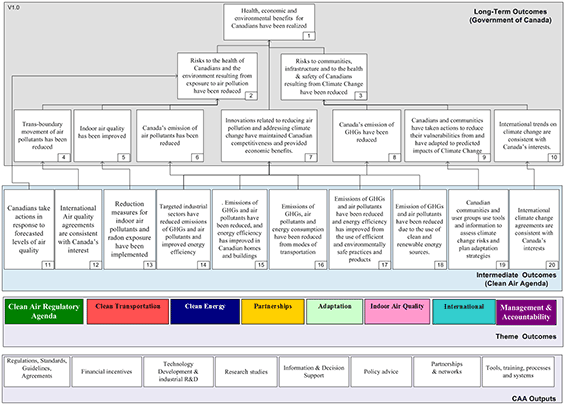
Final
Prepared by Government Consulting Services for Audit and Evaluation Branch, Environment Canada
November 8, 2010
Previous page | Table of Contents | Next page
This section provides an overview of the CAA under these headings:
In the 2006 Speech from the Throne, the Government committed to taking measures to achieve tangible improvements in our environment, including reductions in air pollutant and greenhouse gas (GHG) emissions.
Budget 2006 committed $1.7 billion, later increased to $2.2 billion, to the Clean Air Agenda (CAA) for the four-year period from 2007–2008 to 2010–2011.
The CAA comprises:
The CAA is a horizontal initiative comprising eight themes and 45 programs. (Note: The Agenda was expanded to include the Clean Energy Dialogue as a component of the International Actions theme in 2009–2010).
A tabular overview of the eight themes is presented on the next page, followed by lists of the program components within each theme, identifying the departments delivering the program.
Detailed information on the Agenda and the program components are available in the 2008–2009 Environment Canada Departmental Performance Report, Supplementary Table: Horizontal Initiatives: http://www.tbs-sct.gc.ca/dpr-rmr/2008-2009/index-eng.asp?acr=1481.
Theme
Lead department
2007–2011
Allocation
Clean Energy
Natural Resources Canada
$1177.0 M
Clean Transportation
Transport Canada
$461.7 M
Indoor Air Quality
Health Canada/National Research Council
$23.0 M
Adaptation
Environment Canada
$115.9 M
International Actions
Environment Canada
$50.0 M
Management and Accountability
Environment Canada
$5.0 M
a This
total does not include additional funds under a reprofiling of CARA
that was approved in 2009.
b Note: the
Partnerships theme was not launched.
Source: Environment Canada, 2008–2009 Departmental Performance Report, Supplementary Information, Table: Horizontal Initiatives. http://www.tbs-sct.gc.ca/dpr-rmr/2008-2009/index-eng.asp?acr=1481. Unless otherwise stated, all budget allocation numbers reported in this document are from this source.
Clean Air Regulatory Agenda (EC)
Clean Energy (NRCan)
International Actions (EC)
Partnerships (EC)
Clean Transportation (TC)
Indoor Air Quality (HC/NRC)
Adaptation (EC)
Management and Accountability (EC)
| 2007–2008a | 2008–2009a | |||
|---|---|---|---|---|
| Theme | Approved | Actual | Approved | Actual |
Source: Environment Canada, 2007–08 and 2008–2009 Departmental Performance Report, Supplementary Information, Table: Horizontal Initiatives. a Expenditures reported here may differ from those reported by individual departments or CAA themes due to differences in reporting periods. b Although the Partnerships theme program activities were not launched, some expenditures were incurred during the program’s planning phase. |
||||
| Clean Air Regulatory Agenda (CARA)a | $63.8 M | $42.2 M | $76.0 M | $62.6 M |
| Clean Energy | $101.5 M | $81.6 M | $206.9 M | $202.5 M |
| Clean Transportation | $98.8 M | $92.6 M | $219.4 M | $160.4 M |
| Indoor Air Quality | $5.5 M | $4.6 M | $6.4 M | $6.4 M |
| Adaptation | $7.3 M | $5.7 M | $26.0 M | $20.3 M |
| International Actions | $13.2 M | $7.8 M | $10.7 M | $9.7 M |
| Partnershipsb | $3.0 M | $1.0 M | $3.0 M | $0.3 M |
| Management and Accountability | $1.3 M | $1.2 M | $1.3 M | $1.0 M |
| Total | $294.4 M | $236.7 M | $549.7 M | $463.4 M |
Figure 1: Agenda Logic Model

This figure shows the logic model for the Clean Air Agenda, giving a graphical depiction of how CAA outputs support the outcomes of each Theme, as well as how the intermediate outcomes of the Clean Air Agenda contribute to the fulfillment of long-term outcomes of the Government of Canada.
EC is the lead department on the overall CAA and is responsible for the Clean Air Agenda-Results Management Secretariat (CAA-RMS). In all, eight government departments (EC; NRCan; TC; NRC; INAC; HC; PHAC; and DFAIT) are responsible for themes and/or individual programs. Two additional departments (Industry Canada and Human Resources and Skills Development Canada) are partners in specific programs.
The CAA accountability structure is composed of these interdepartmental committees:
The DGTLCC is the primary operational committee responsible for implementing the elements of the CAA, comprising the leads from each of the eight DG Theme Management Committees.
The CAA-RMS is the main support structure for the CAA Management and Accountability theme. Its key functions include:
1 Descriptions of each of the CAA program components are included in the Environment Canada Departmental Performance Report, Supplementary Table: Horizontal Initiatives. The 2008–09 supplementary table is published at http://www.tbs-sct.gc.ca/dpr-rmr/2008-2009/index-eng.asp?acr=1481.